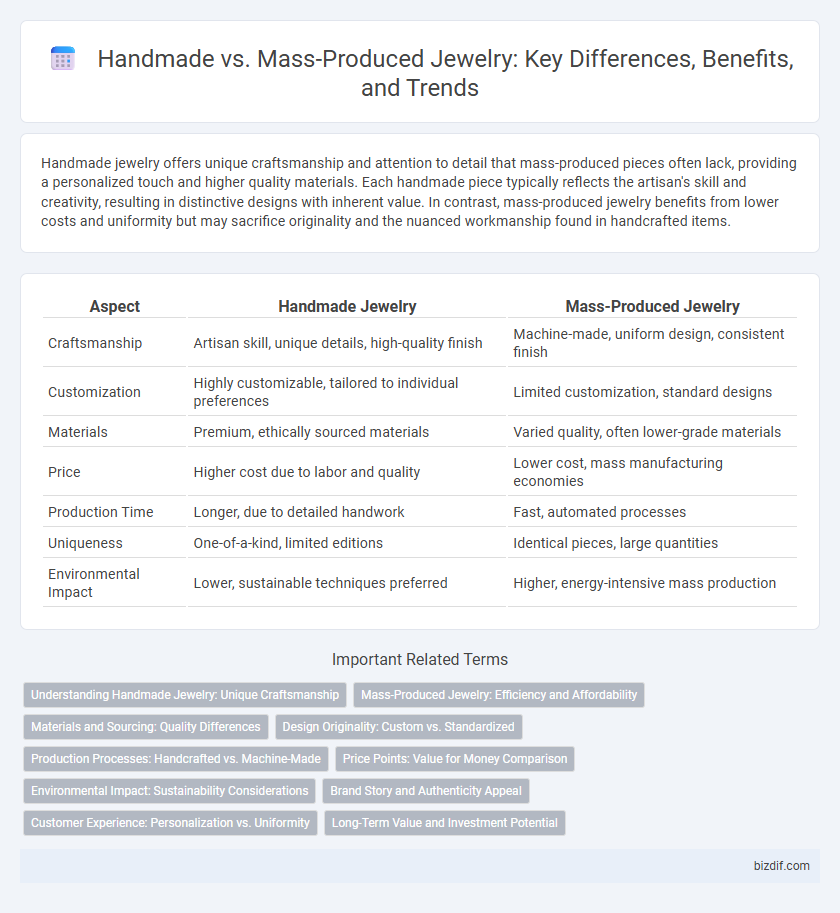Handmade jewelry offers unique craftsmanship and attention to detail that mass-produced pieces often lack, providing a personalized touch and higher quality materials. Each handmade piece typically reflects the artisan's skill and creativity, resulting in distinctive designs with inherent value. In contrast, mass-produced jewelry benefits from lower costs and uniformity but may sacrifice originality and the nuanced workmanship found in handcrafted items.
Table of Comparison
| Aspect | Handmade Jewelry | Mass-Produced Jewelry |
|---|---|---|
| Craftsmanship | Artisan skill, unique details, high-quality finish | Machine-made, uniform design, consistent finish |
| Customization | Highly customizable, tailored to individual preferences | Limited customization, standard designs |
| Materials | Premium, ethically sourced materials | Varied quality, often lower-grade materials |
| Price | Higher cost due to labor and quality | Lower cost, mass manufacturing economies |
| Production Time | Longer, due to detailed handwork | Fast, automated processes |
| Uniqueness | One-of-a-kind, limited editions | Identical pieces, large quantities |
| Environmental Impact | Lower, sustainable techniques preferred | Higher, energy-intensive mass production |
Understanding Handmade Jewelry: Unique Craftsmanship
Handmade jewelry showcases unparalleled craftsmanship through meticulous attention to detail and individual artistry, resulting in unique pieces that often carry emotional and cultural significance. Each item is carefully shaped and finished by skilled artisans, using traditional techniques that preserve the authenticity and character of the design. Compared to mass-produced jewelry, handmade creations emphasize quality materials and personalized touches, making them valuable collector's items and meaningful gifts.
Mass-Produced Jewelry: Efficiency and Affordability
Mass-produced jewelry leverages advanced machinery and streamlined manufacturing processes to achieve high efficiency, significantly reducing production time compared to handcrafted pieces. This method allows for the creation of uniform designs in large quantities, driving down costs and making stylish accessories more accessible to a broader market. Economies of scale in mass production also enable retailers to offer competitive pricing without compromising basic quality standards.
Materials and Sourcing: Quality Differences
Handmade jewelry often utilizes ethically sourced, high-quality materials such as gemstones and metals that are carefully selected for durability and aesthetic appeal. In contrast, mass-produced pieces may rely on lower-grade components and synthetic substitutes to reduce costs, potentially compromising the longevity and overall finish. The sourcing transparency found in handmade jewelry ensures traceability and better environmental practices, setting it apart from large-scale manufacturing processes.
Design Originality: Custom vs. Standardized
Handmade jewelry showcases unique design originality through custom craftsmanship tailored to individual preferences, offering one-of-a-kind pieces that reflect personal style and creativity. Mass-produced jewelry relies on standardized designs, prioritizing uniformity and cost-efficiency over individualized artistry. Custom handmade creations often feature intricate details and exclusive materials, setting them apart from the repetitive patterns found in mass-produced collections.
Production Processes: Handcrafted vs. Machine-Made
Handmade jewelry involves meticulous craftsmanship where artisans shape, solder, and polish each piece individually, ensuring unique details and high-quality finishes. In contrast, mass-produced jewelry relies on automated machinery and molds to rapidly create uniform items, emphasizing efficiency and cost-effectiveness. The handcrafted process allows for customization and intricate designs, while machine-made production excels in scalability and consistent replication.
Price Points: Value for Money Comparison
Handmade jewelry often commands higher price points due to the skilled craftsmanship, unique designs, and high-quality materials used, offering exceptional value for money to those seeking one-of-a-kind pieces. Mass-produced jewelry benefits from economies of scale, resulting in lower prices that cater to budget-conscious consumers but may sacrifice uniqueness and artisanal detail. Evaluating these price points, customers must balance the desire for exclusivity and craftsmanship with affordability and mass availability.
Environmental Impact: Sustainability Considerations
Handmade jewelry typically has a lower environmental impact than mass-produced pieces due to the use of sustainable materials and energy-efficient techniques that minimize waste. Artisans often source recycled metals and ethically mined gemstones, reducing the carbon footprint associated with extraction and manufacturing processes. In contrast, mass production relies heavily on industrial processes that consume more energy and generate significant pollution, contributing to unsustainable environmental degradation.
Brand Story and Authenticity Appeal
Handmade jewelry carries a unique brand story that deeply resonates with consumers seeking authenticity and craftsmanship. Each piece reflects the artisan's skill, passion, and cultural heritage, creating emotional value unmatched by mass-produced items. Brands emphasizing handmade origins attract discerning customers who prioritize originality and meaningful connections over uniformity.
Customer Experience: Personalization vs. Uniformity
Handmade jewelry offers a personalized customer experience by allowing unique designs tailored to individual preferences, fostering emotional connections and exclusivity. Mass-produced jewelry emphasizes uniformity, providing consistent quality and affordability but lacking the bespoke charm of handcrafted pieces. Consumers seeking meaningful, one-of-a-kind accessories gravitate toward artisanal creations, while those prioritizing convenience and budget favor mass-produced options.
Long-Term Value and Investment Potential
Handmade jewelry often retains higher long-term value due to its unique craftsmanship, limited availability, and use of premium materials, making it a more attractive investment. Mass-produced pieces lack individuality and are typically made with lower-cost components, which can diminish their resale value over time. Collectors and investors favor handmade jewelry for its potential to appreciate in value and hold sentimental worth across generations.
Handmade vs Mass-Produced Infographic

 bizdif.com
bizdif.com